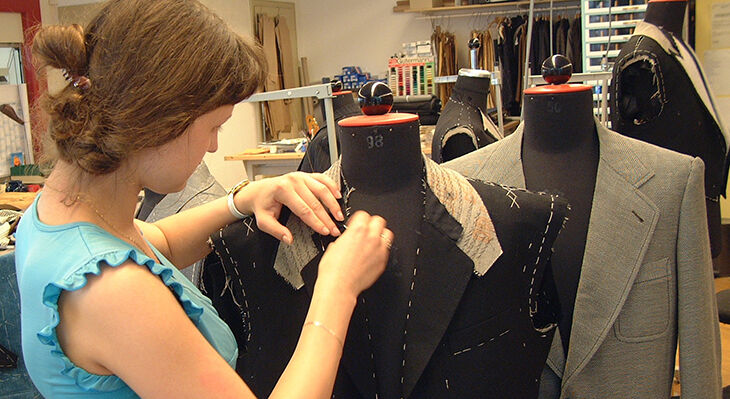Profile of an occupation – custom tailor
There is a training occupation separate from the fashion industry which combines creativity, dexterity, traditional craft skills and modern manufacturing processes. Custom tailors use their flair for design and fashion to produce everything from classic suits to theatrical costumes to one-off haute couture pieces for private persons and for the stage. This occupational profile sets out their most important tasks and provides training figures.

Individual, traditional and highly modern
The profession of tailor has changed considerably over time. The introduction of the sewing machine around 1860 and the invention of cutting and buttonhole machines enabled the spread of the ready-made clothing industry. Today, clothing is produced in low-wage countries and sold via online shops. These developments have also led to a decline in tailoring. All that remains are shops offering alterations and repairs and small craft trade companies specialising in the premium segment of bespoke handmade tailoring using traditional techniques. This approach allows consideration to be given to special design requests, to particular wishes regarding materials, and to individual measurements and body shapes. However, traditional tailoring has not merely survived as a niche area for connoisseurs and enthusiasts. Germany still has numerous tailoring companies offering a wide range of services.
Specialisms – ladies and gentlemen
Until 2004, a distinction was drawn between men’s tailors, dressmakers and linen tailors. Because these disciplines intersect in many areas, training has taken place by means of a joint occupational profile since this time. A difference is still made between the specialisms of “ladies” and “gentlemen” because the manufacturing techniques for male and female custom clothing vary. These differences essentially relate to the materials used. Cutting designs also follow fundamentally different systems. Custom tailors work for craft trade companies which have usually specialised in either female or male fashion. Many of Germany’s 140 publicly funded theatres and opera houses also have costume workshops where custom tailors are trained and employed. Custom tailors at theatres make the costumes that have been designed for a stage production. These include historical clothing, undergarments, corsages, ballet costumes, fantasy costumes and animal costumes in every possible style. Custom tailors at theatres also help out backstage by assisting performers in getting dressed and changed and by carrying out minor repairs and alterations. They are in demand in the film and TV industries too.
Custom tailors develop and create designs in line with fashion-related, functional, historical and technological aspects whilst understanding the correlation between style, body shape, cut and workmanship. Once the processing technique has been stipulated, materials and component parts are selected according to their properties and intended use. Custom tailors prepare their own templates which they use to cut cloth. Various types of stitching and sewing are deployed to finish the garment on the basis of the pattern. Great attention to detail must also be paid when completing partial works such as pockets, edges, vents, sleeves and collars. The field of activity further encompasses the modernisation and alteration of clothing.
An occupation which is not falling out of fashion despite falling training figures

Foto-Download (Bild, 203 KB)
The number of trainees has decreased steadily over the past years, even though figures have stabilised recently and even rose slightly once more in 2022. There were 378 new training contracts in 2012, around 92.3 percent of which were concluded with women. Ten years later, in 2022, the corresponding figures were 165 newly concluded training contracts and a female proportion of 83.7 percent. This means that the proportion of new trainees who are male has doubled since 2012 (see Figure).
The desire of private persons for individual, high-end clothing and the requirements of tailoring workshops at theatres and in film and television mean that there are good career prospects upon completion of training. Advanced VET leading to a master craftsman qualification in ladies’ and gentlemen’s tailoring or to the qualification of wardrobe director, for example, provide opportunities to become self-employed as the owner of a bespoke atelier or to advance to the position of head of the costume workshop at an opera house. Custom tailors are also in demand at fashion companies because of their knowledge of the craft and their skills.
The occupation is not merely characterised by traditional craft trade techniques. Technological developments are also changing and expanding the work of custom tailors. Computer-aided design software is making it possible to create and edit digital patterns. 3D printing and digital knitting machines can help with the manufacture of clothing. 3D body scanners can be deployed to measure customers and to optimise the fit of garments. This all makes companies attractive employers for young skilled workers, and digital media are also used to appeal to younger customers. Traditional tailoring is in tune with the awareness that clothing should be sustainable. A made-to-measure suit can be repaired. It can also be adjusted to changed body measurements or to provide a more modern fit and can thus be worn for many years.
Full-time school-based training
Specialist fashion schools and vocational schools also offer full-time school-based training in accordance with federal state regulations. The foundation for this is provided by the dual training regulations which stipulate practical phases at various companies. Intermediate and journeyman examinations are normally conducted by the Chambers of Crafts and Trades responsible.
At a glance
- Last update: 2004
- Duration of training: 3 years
- Responsibility: craft trades sector
- Training structure: training occupation with two specialisms
- Ladies
- Gentlemen
- DQR reference level: 4
- Advanced vocational training: master craftsman qualification in ladies' and gentlemen's tailoring, qualification of wardrobe director
Further links (in German)
BIBB / Informationen zu Aus- und Fortbildungsberufen
BIBB / "Ausbildung gestalten" Maßschneider/Maßschneiderin
BWP / Podcast AzubiView (13): Maßschneider/-in
(All links: status 4/12/2024)
(Compiled by Arne Schambeck, BWP)
Translation from the German original (published in BWP 4/2024): Martin Kelsey, GlobalSprachTeam, Berlin